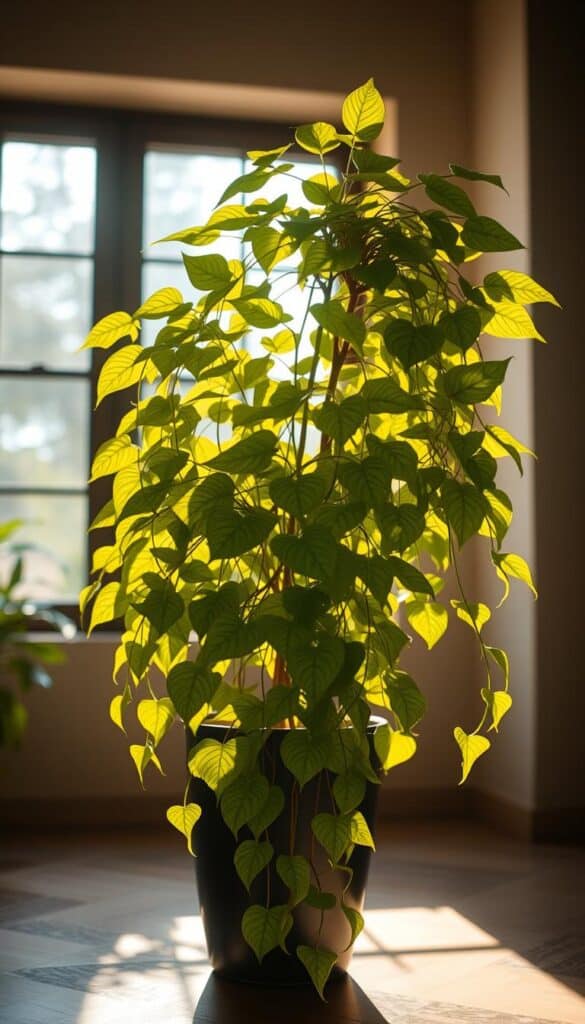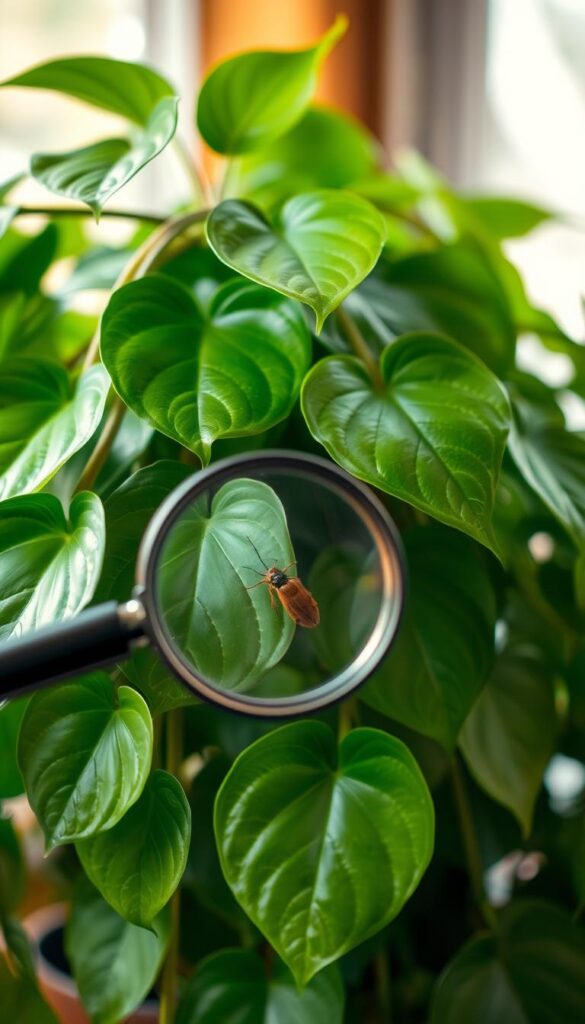Have you ever wondered how to bring a touch of nature indoors without much hassle? For me, the journey with golden pothos began when I received a small cutting from a friend. This resilient vine, often called devil’s ivy, quickly became my favorite houseplant. Its heart-shaped leaves and vibrant variegation add a pop of color to any room, and it’s incredibly adaptable—perfect for both beginners and seasoned plant enthusiasts.
Golden pothos is more than just a pretty face. It’s one of the fastest-growing houseplants, adding 12 to 18 inches of new growth every month. Whether you let it cascade from a hanging basket or train it to climb up a moss pole, it’s sure to impress. Plus, it thrives in bright, indirect light, making it ideal for indoor spaces.
Caring for golden pothos is straightforward, but there are a few key things to keep in mind. Proper watering, balanced light exposure, and maintaining the right temperature will keep your plant healthy and its variegation vibrant. While it’s low-maintenance, giving it the right care ensures it stays lush and beautiful for years to come.
– Golden pothos is a fast-growing, adaptable houseplant perfect for indoor spaces.
– It thrives in bright, indirect light and requires balanced watering and temperature.
– Proper care ensures vibrant variegation and healthy growth.
Embracing the Beginner Mindset: My Pothos Story
My journey with the pothos plant began when I received a small cutting from a friend. What started as a curious experiment quickly turned into a passion. I was captivated by how this unassuming vine could transform a space with its elegant, heart-shaped leaves and vibrant variegation.
Why I Fell in Love with the Pothos Plant
The pothos plant won me over with its resilience and adaptability. It thrived in bright, indirect light and required minimal care, making it perfect for my busy lifestyle. I loved how it could grow in various conditions, from low-light areas to sunny spots, always maintaining its beauty.
The Allure of a Low-Maintenance Houseplant
| Care Aspect | Tip | Frequency |
|---|---|---|
| Watering | Allow soil to dry slightly between waterings | Once a week |
| Fertilizing | Use a balanced, water-soluble fertilizer | Monthly |
| Pruning | Trim long vines to encourage fullness | Every 2 months |
| Propagation | Take stem cuttings with at least 2 nodes | As needed |
I found joy in the simple acts of caring for my pothos. Whether it was propagating cuttings or watching new leaves unfurl, each step felt rewarding. This plant taught me that even small moments of care can lead to significant growth and beauty.
Understanding Pothos Basics and Ideal Growing Conditions
To keep your pothos thriving, it’s essential to understand its basic needs and ideal growing conditions. This resilient plant flourishes in bright, indirect light, making it perfect for indoor spaces. Direct sunlight can scorch its vibrant leaves, so placing it near an east- or west-facing window is ideal.
Light, Temperature, and Humidity: What Works Best
Pothos prefers bright, indirect light but can adapt to low-light conditions. However, direct sun can damage its leaves. Maintain a temperature between 65°F and 75°F and humidity levels of 40-60% to keep your plant healthy and stress-free.
Selecting the Right Potting Soil and Fertilizer
Use a well-draining potting mix, such as an aroid mix, to support healthy root development. A pot with drainage holes is crucial to prevent waterlogged soil. Feed your plant with a balanced, water-soluble fertilizer monthly during spring and summer for optimal growth.

Allow the soil to dry completely between waterings to prevent root rot. Check moisture by inserting your finger into the soil up to the first knuckle. Proper care ensures vibrant variegation and healthy growth, making your pothos a stunning indoor addition.
Mastering Growing Golden Pothos at Home: Step-by-Step Essentials
Bringing life into your space with a pothos plant is easier than you think. With the right techniques, you can propagate, care for, and enjoy the beauty of this versatile vine. Let’s dive into the essential steps to help your plant thrive.
Choosing, Propagating, and Watering Your Plant
Starting with a healthy stem cutting is key. Look for stems with at least two nodes and plenty of leaves. Using a clean tool, make a cut just below a node to encourage root development. Place the cutting in water, ensuring the node is submerged, and wait for roots to form—usually within 2-3 weeks.
Once roots develop, transfer the cutting to a pot with well-draining soil. Water thoroughly but avoid overwatering. Keep the soil moist but not soggy, checking the top inch of soil before watering again.
Maintaining Variegation and Monitoring Growth
Variegation thrives in bright, indirect light. Placing your plant near an east- or west-facing window provides ideal conditions. Direct sunlight can cause leaf scorch, so sheer curtains can help diffuse strong rays.
Regular trimming is essential for maintaining shape and encouraging new growth. Cut back long vines to promote a fuller plant, and remove any discolored leaves to preserve variegation.
| Care Aspect | Tip | Frequency |
|---|---|---|
| Watering | Allow top inch of soil to dry | Once a week |
| Fertilizing | Use balanced, water-soluble fertilizer | Monthly |
| Pruning | Trim below a node | Every 2 months |
| Propagation | Take 4-5 inch stem cuttings | As needed |
By following these steps, you’ll create an environment where your pothos can flourish. With proper care, your plant will become a stunning addition to your indoor space.
Handling Common Pothos Challenges and Pests
Like any houseplant, pothos can face challenges that affect its health. The most common issues are overwatering and pests. Recognizing these problems early is key to keeping your plant thriving.
Recognizing Signs of Overwatering and Yellow Leaves
Yellow, drooping leaves are often a sign of overwatering. Check the soil by inserting your finger up to the first knuckle. If the soil feels soggy, it’s time to wait before watering again. Allow the top inch of soil to dry out between waterings, especially during winter when growth slows down. Proper drainage is crucial to prevent root rot, so ensure your pot has drainage holes and use a well-draining soil mix.
Effective Pest Control Techniques
Spider mites, mealybugs, and scale can infest your pothos, causing damage and discoloration. Inspect your plant regularly for tiny spots or white, cottony patches. For pest control, gently wipe leaves with a soft cloth and treat with insecticidal soap or neem oil. Isolate infected plants to prevent pests from spreading to other houseplants. Regular monitoring and maintaining optimal conditions will help keep your pothos healthy and pest-free.

Pruning, Propagating, and Repotting for a Thriving Vine
Keeping your pothos vine healthy and attractive involves regular pruning, propagating, and repotting. These practices not only maintain its shape but also encourage robust growth.
My Tips for Pruning and Shaping Your Pothos
Pruning is essential to keep your pothos looking its best. Use clean, sharp tools to remove dead or leggy stems, which helps prevent disease and encourages a bushier vine. Always cut just below a node to promote new growth and maintain the plant’s natural form.
When propagating, choose stem cuttings with at least two nodes. Remove lower leaves and dip the cut end in rooting hormone for better results. Place the cutting in water or soil, ensuring the node is submerged or covered. Roots typically develop within a few weeks.
Repot your pothos when it becomes pot-bound, usually every 1-2 years. Select a slightly larger pot with drainage holes and fresh, well-draining soil. This gives the roots room to grow and keeps your plant thriving.
By balancing propagation with continued care, you ensure all cuttings have the potential to succeed. Regular pruning revitalizes the vine, stimulating new growth while preserving its natural beauty.
Reflecting on My Pothos Journey and Planning Future Care
Reflecting on my journey with pothos, I’ve learned that consistent care and attention are key to keeping this plant thriving. Over time, I’ve refined my watering schedule and potting mix to ensure the best conditions for healthy growth.
Planning future care involves regular check-ups on soil conditions and light exposure. Monthly routines help maintain the right balance, especially during winter when growth slows. Adjusting for temperature changes ensures robust growth year-round.
Using a well-draining potting mix remains a priority, as does proper drainage in the pot. These practices have kept my pothos vibrant and thriving, even as a beginner.
I encourage fellow indoor gardeners to stay patient and observant. Each week’s care contributes to long-term health, making the effort worthwhile for a stunning, lasting display.
